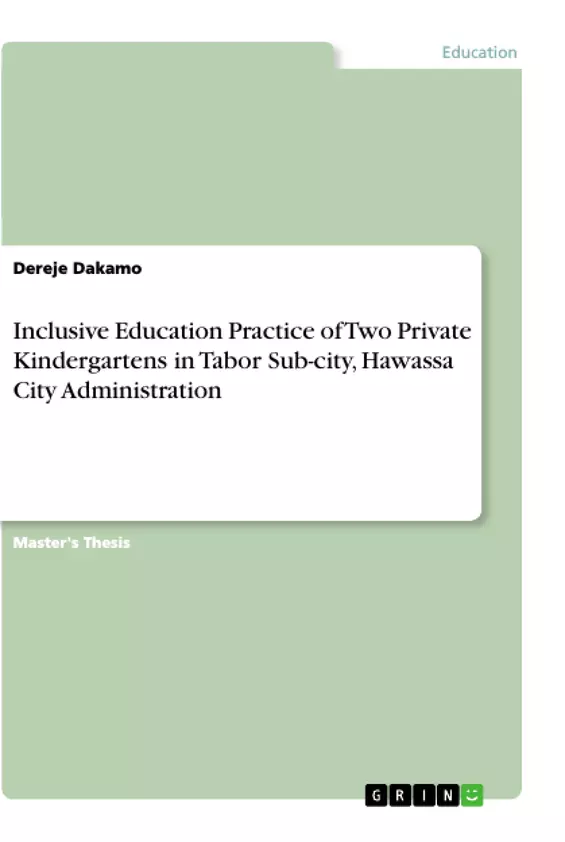This study was aimed at investigating the implementation of inclusive education in two private kindergartens in Tabor Sub-city, Hawassa City Administration. Early inclusion and intervention has the greatest impact on child’s learning and development. Conducting research on this kind of issue is expected to have a significant role providing insights to improve the practice. Factors that hinder proper implementation of inclusive education in selected private kindergartens had been investigated across this research. To find solution for the problem stated above, all participants who were believed to give rich information were purposively selected. Qualitative research method specifically phenomenological approach was employed and all necessary studies conducted before were critically reviewed. There were about twenty eight key informants involved in the study. They were six children with disabilities, two kindergarten principals, twelve teachers/assistants, six parents and two officers from the centers. Document analysis, semi-structured interview, participant observation and focus group discussion were data gathering tools employed. All raw data were transcribed and narrated in to meaningful report. Even though both kindergartens claim that they are inclusive, finding shows that they are not inclusive. Neither physical nor social environment of both kindergartens was accessible for children with disabilities. Absence of trained manpower, lack of knowledge with regard to inclusion of children with special needs and negative attitude of the parents were factors hindering the implementation of inclusive education in the kindergartens. Findings imply that teachers, principals and parents need awareness raising training, and private kindergartens have to assign special need education teachers so as to promote inclusion of children with disabilities.
Inhaltsverzeichnis (Table of Contents)
- Chapter One
- Introduction
- Background of the Study
- Statement of the Problem
- Objectives of the Study
- General Objective
- Specific Objectives
- Significance of the Study
- Scope of the Study
- Theoretical and Conceptual Framework
- Operational Definition of Terminologies
- Limitation of the Study
- Organization of the Paper
- Chapter Two
- Review of the Related Literature
- Definition of Early Childhood Inclusion
- Rational for Inclusive Early Childhood Care and Education
- Human Right & Moral/Ethical Justification
- Brain Development
- Social Equity and Reducing Early Disadvantage
- Economic Justification
- Inclusion in Education
- Historical Development of Early Childhood Inclusive Education
- Elements of Inclusive Education
- Environment, Engagement and Inclusion
- Communication and Technology Support
Zielsetzung und Themenschwerpunkte (Objectives and Key Themes)
This thesis examines the inclusive education practices of two private kindergartens in the Tabor Sub-city of Hawassa City Administration. The study aims to understand the extent to which these kindergartens are implementing inclusive practices and identify the challenges and successes associated with this approach.
- Inclusive education practices in early childhood settings
- Challenges and opportunities for inclusive education in Ethiopia
- The role of private kindergartens in promoting inclusive education
- The impact of inclusive practices on children with diverse needs
- The importance of teacher training and support for successful inclusive education
Zusammenfassung der Kapitel (Chapter Summaries)
Chapter One provides a comprehensive introduction to the study, outlining its background, problem statement, objectives, significance, scope, theoretical framework, operational definitions, limitations, and organization. Chapter Two presents a detailed review of related literature, exploring the concept of early childhood inclusion, its rationale, historical development, and key elements. This chapter delves into the importance of inclusive education for children with diverse needs and the challenges and benefits associated with this approach.
Schlüsselwörter (Keywords)
This study focuses on inclusive education practices in early childhood, specifically within the context of two private kindergartens in Hawassa City Administration. Key terms and concepts explored include: inclusive education, early childhood, private kindergartens, Ethiopia, challenges, opportunities, teacher training, and children with diverse needs.
- Arbeit zitieren
- Dereje Dakamo (Autor:in), 2018, Inclusive Education Practice of Two Private Kindergartens in Tabor Sub-city, Hawassa City Administration, München, GRIN Verlag, https://www.grin.com/document/520310



